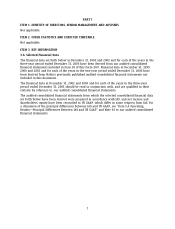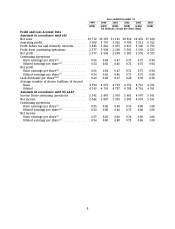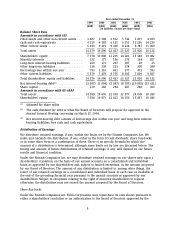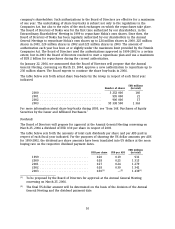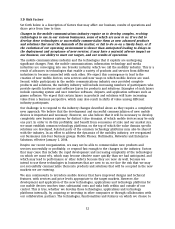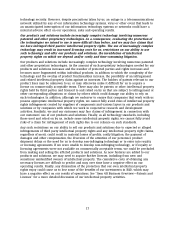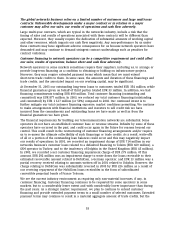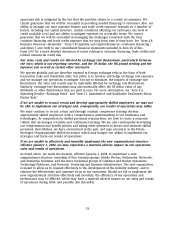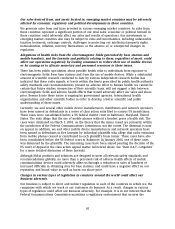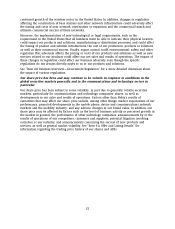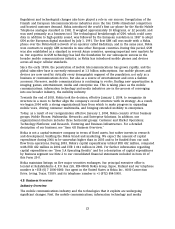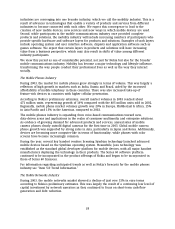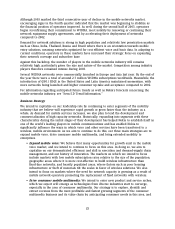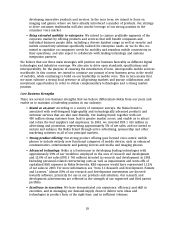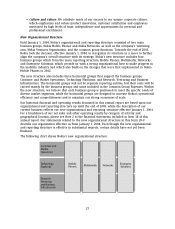Nokia 2003 Annual Report Download - page 18
Download and view the complete annual report
Please find page 18 of the 2003 Nokia annual report below. You can navigate through the pages in the report by either clicking on the pages listed below, or by using the keyword search tool below to find specific information within the annual report.technology security. However, despite precautions taken by us, an outage in a telecommunications
network utilized by any of our information technology systems, virus or other event that leads to
an unanticipated interruption of our information technology systems or networks could have a
material adverse effect on our operations, sales and operating results.
Our products and solutions include increasingly complex technology involving numerous
patented and other proprietary technologies. As a consequence, evaluating the protection of
the technologies we intend to use is more difficult than before, and we may face claims that
we have infringed third parties’ intellectual property rights. The use of increasingly complex
technology may result in increased licensing costs for us, restrictions on our ability to use
such technology and offer our products and solutions, the invalidation of intellectual
property rights on which we depend and/or costly and time-consuming litigation.
Our products and solutions include increasingly complex technology involving numerous patented
and other proprietary technologies. As the amount of such proprietary technologies needed for our
products and solutions increases and the number of protected parties and rights increases and
becomes more fragmented within individual products, in addition to which the complexity of the
technology and the overlap of product functionalities increase, the possibility of an infringement
and related intellectual property claim against us increases. The holders of patents relevant to our
product lines may be unknown to us, or may otherwise make it difficult for us to acquire a
license on commercially acceptable terms. There may also be patents or other intellectual property
rights held by third parties and licensed to and relied on by us that are subject to infringement or
other corresponding allegations or claims by others which could damage our ability to rely on
such technologies. In addition, although we endeavor to ensure that companies that work with us
possess appropriate intellectual property rights, we cannot fully avoid risks of intellectual property
rights infringement created by suppliers of components and various layers in our products and
solutions or by companies with which we work in cooperative research and development
activities. Similarly, we and our customers may face claims of infringement in connection with
our customers’ use of our products and solutions. Finally, as all technology standards, including
those used and relied on by us, include some intellectual property rights, we cannot fully avoid
risks of a claim for infringement of such rights due to our reliance on such standards.
Any such restrictions on our ability to sell our products and solutions due to expected or alleged
infringements of third party intellectual property rights and any intellectual property right claims,
regardless of merit, could result in material losses of profits, costly litigation, the payment of
damages and other compensation, the diversion of the attention of our personnel, product
shipment delays or the need for us to develop non-infringing technology or to enter into royalty
or licensing agreements. If we were unable to develop non-infringing technology, or if royalty or
licensing agreements were not available on commercially acceptable terms, we could be precluded
from making and selling the affected products and solutions. As new features are added to our
products and solutions, we may need to acquire further licenses, including from new and
sometimes unidentified owners of intellectual property. The cumulative costs of obtaining any
necessary licenses are difficult to predict and may over time have a negative effect on our
operating results. Finally, any diminution of the protection that our own intellectual property
rights enjoy could cause us to lose some of the benefits of our investments in R&D, which may
have a negative effect on our results of operations. See ‘‘Item 4.B Business Overview—Patents and
Licenses’’ for a more detailed discussion of our intellectual property activities.
17


